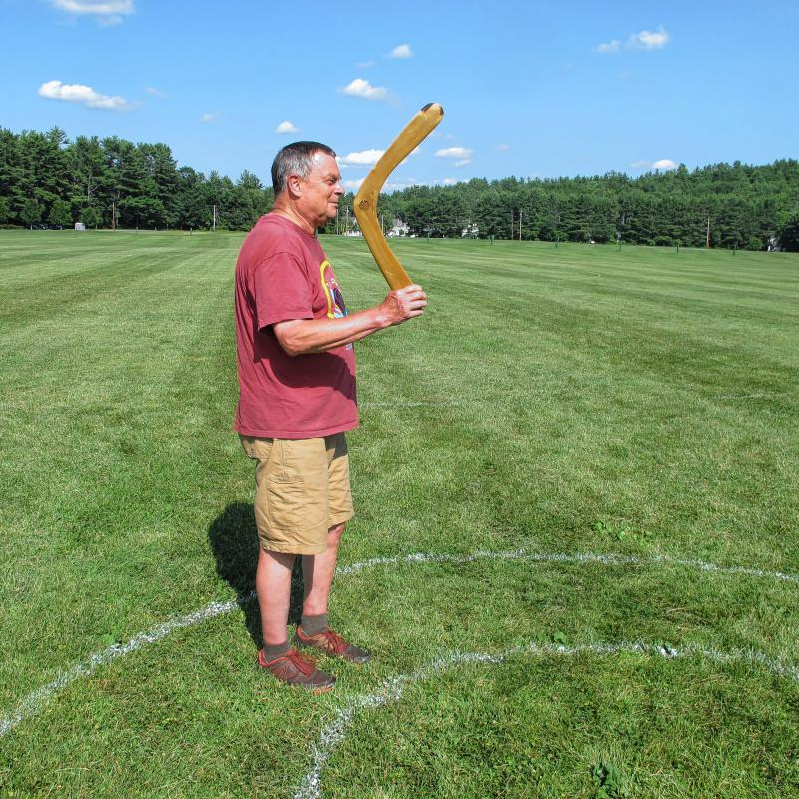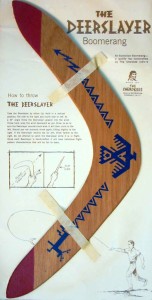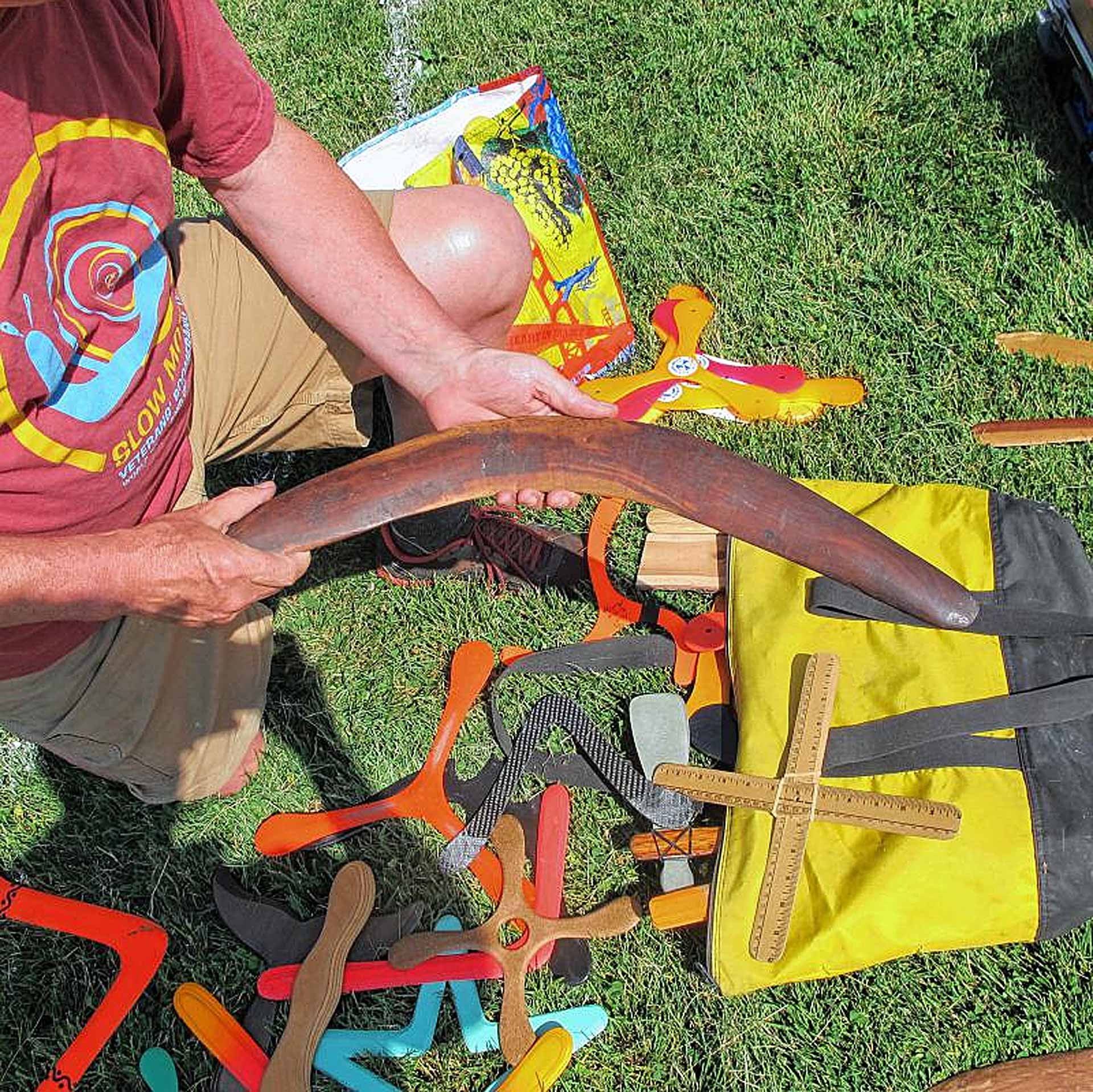O escritor e designer Henry Homeyer levou 60 anos para realizar um desejo de criança. Jogar e pegar um bumerangue.
Por Henry Homeyer para o Valley News
Quando eu era um menino de 8 anos, me deram um bumerangue de presente. Por ser feito de madeira compensada, não tive a ilusão de que era um bumerangue aborígene original, feito na Austrália. Mas eu acreditava que se jogasse direito, voltaria.
Passei horas no meu quintal lançando o artefato. Mas nunca voltou. Eu jogava, ia buscá-lo e jogava novamente, sempre acreditando que eu acabaria por dominar a arte de lançar o bumerangue.
Persistência compensa. Sessenta anos mais tarde, eu conheci alguém disposto – e capaz – de me ensinar como fazer o bumerangue voltar.
Eric Darnell, de Strafford, foi por seis vezes campeão mundial de bumerangue, cinco delas como jogador e uma vez como técnico. Durante 13 anos, ele deteve um dos recordes mundiais.
Eu o conheci há um ano atrás enquanto aguardava um ônibus para ir até Boston. Quando perguntei o que ele fazia. Ele me disse que já havia inventado várias coisas. Não só bumerangues, mas também capacetes esportivos e até um fogão a lenha. Então liguei para Eric recentemente, e ele me lembrou que havia se oferecido para me ensinar a jogar bumerangues.
Nós nos encontramos em uma tarde ensolarada em Chase Field, Hanover. Ele carregava um verdadeiro museu: bumerangues aborígenes genuínos, bumerangues de plástico, bumerangues de madeira compensada e até o bumerangue que eu tinha quando criança – Deerslayer.
Fiquei de queixo caído. O exemplar estava em sua embalagem original, de celofane, e ainda etiquetado com o preço de 1950: US$ 3,99. Perguntei para Darnell sobre o exemplar. “Este não volta, design ruim”. Senti minha confiança inflar. Talvez eu fosse capaz de jogar e pegar um bumerangue, mas nem sabia disso.
Primeiro, Darnell fincou um tipo de biruta no chão, com fitas de plástico ligadas na ponta, que nos permitiram ver se havia uma leve brisa, e que direção ela estava soprando. As instruções do bumerangue Deerslayer sequer citavam esta “regra”, mas Darnell disse que a direção do vento é importante. Devemos lançar um bumerangue um pouco abaixo do ângulo reto, a direita do vento – se você é destro, e à esquerda do vento – se você é canhoto. Muitas vezes antes de jogar um bumerangue ele arrancava algumas folhas de grama e as jogava ao ar, observando o caminho que a brisa soprava no momento exato do lançamento. Darnell explicou que os aborígines usavam bumerangues principalmente pela alegria de observar o vôo, e para mostrar suas habilidades.
Aborígenes também jogavam “varas” semelhantes a bumerangues, os kylies, mas apenas para abater animais. A vantagem destas é que, ao contrário de uma lança ou flecha, o animal não via o kylie se aproximando – as varas seguiam um padrão de vôo levemente curvo: cangurus desavisados eram pegos de surpresa. Bumerangues também eram ocasionalmente jogados em bando de pássaros, mas eles nunca foram considerados armas em seu ambiente nativo.
Finalmente, o momento da verdade chegou. Darnell me disse para mirar o bumerangue acima do topo de alguns bordos. Então eu fiz, e o bumerangue decolou, mas fez a volta na direção errada. O vento havia mudado, ele disse. Então joguei de novo, e ele veio em minha direção… mas caiu. Na terceira ou quarta tentativa, eu peguei o bumerangue! Vitória.
Fui para casa com lotes de bumerangues, presentes de Darnell. Ele é tão generoso, talvez uma falha, pois disse que já participou de competições onde foi massacrado por concorrentes que utilizaram bumerangues emprestados por ele. Recentemente, participou de uma competição internacional em Perth, Austrália, onde treinou a equipe japonesa para a vitória. Agora que se aproxima de 70, Darnell não compete mais. Mas ainda gosta de jogar e vê-los voar. Ser um bom jogador não requer força, mas habilidade, disse ele.
Bumerangues são uma boa metáfora para a vida. O que você faz é o que você recebe de volta, filosofou. Quanto melhores forem as condições de lançamento, melhores serão os resultados. Vou continuar jogando bumerangues? Pode apostar. Tudo que eu preciso é um grande campo aberto e minha coleção de bumerangues do Darnell. É um bom exercício, muitas vezes você dá apenas alguns passos até chegar ao ponto certo de pegá-los. Para mim, pelo menos, os bumerangues raramente voltam para o lugar exato de onde foram jogados. Com os bumerangues de plástico inventados e produzidos pelo Darnell, você pode ajustar as extremidades para compensar o vento ou a falta dele.
Eu adoraria ensinar aos meus netos como jogar bumerangues. Dessa vez eles não terão de esperar 60 anos para que eles retornem.
Henry Homeyer é escritor e designer, autor de 5 livros. Seu website: www.gardening-guy.com
After 60 Years, Boomerang Returns
By Henry Homeyer for the Valley News
As an 8-year-old boy I was given a boomerang. It was made of plywood, and I had no illusions that it was an original aboriginal boomerang made in Australia.
But I did believe that if I threw it right, it would come back. I spent hours in my backyard, throwing it again and again. But it never came back. I chased after it — sometimes shaking it out of a tree — always believing that I would eventually master the art of throwing one.
Persistence does pay off. Sixty years later, I met someone who was willing — and able — to teach me how to do it.
Eric Darnell, of Strafford, is a six-time world boomerang champion, five times as a thrower, once as a coach. For 13 years he held the world record for the time a boomerang stayed aloft (1 minute, 45 seconds). I met him a year ago while waiting for the Dartmouth Coach to go to Boston. When I asked what he did, said, “I’m an inventor.” He told me he had invented many different kinds of things. Not only boomerangs, but also sports helmets and a free-flow wood stove. So I called him up recently, and he reminded me that he had offered to teach me how to throw a “ ’rang.”
We met on a sunny afternoon at Chase Field in Hanover. He unloaded a veritable museum of boomerangs: Genuine aboriginal boomerangs, plastic boomerangs, plywood boomerangs, and yes, the boomerang I had as a kid. It was still in its original cellophane packaging with a 1950s price: $3.99. It was touted as the Deerslayer. My jaw dropped. I asked Darnell about it. “Oh,” he said, “That one never comes back. Bad design.” I felt my confidence swelling considerably. Maybe I would actually throw and catch a boomerang. I was ready.
First, Darnell stuck a pole in the ground, with thin plastic streamers attached that allowed us to see if there was even a faint breeze, and which direction it was blowing. The Deerslayer boomerang instructions did not tell me to pay attention to breezes, but Darnell said the direction of the breeze is important. We should throw a boomerang at a little less than a right angle to the breeze, he explained. Throw to the right of the wind if you are right handed, and to the left of the wind if you are left handed. Often before throwing a boomerang he would pull a few blades of grass, drop them from his hand, watching which way the breeze was blowing at the exact moment of throwing.
Darnell explained that the Aborigines used boomerangs mainly for the joy of flying them, and to show off their skills. They had throwing sticks that looked much like boomerangs, but those did not return. Unlike a spear or arrow that an animal can see coming, the throw sticks followed a curved flight pattern, surprising unsuspecting kangaroos or other animals from behind. Yes, he said, boomerangs were occasionally thrown behind birds, mimicking hawks, to scare them into nets, but they were never considered weapons in their native setting.
Finally the moment of truth arrived. Darnell told me to cock the boomerang back so that one arm of the boomerang touched my arm. Wrist action is important, he said, and so is a forward step. We were some 50 yards from a stand of mature maples and he told me to aim my throw just above their tops. So I did, and the boomerang took off, climbing, turning …. and heading off in the wrong direction. The wind had changed, he said, and I had not released it just right. I threw again, and it came toward me … but crashed. On the third or fourth try, I caught my boomerang! Darnell slapped me five. Victory.
I went home with lots of boomerangs, gifts from Darnell. He is generous, perhaps to a fault. He told me that he has attended boomerang competitions where he has been beaten by competitors who were using boomerangs that he had made and lent to them. Recently he went to an international competition in Perth, Australia, where he coached the Japanese team to victory. Now approaching 70, Darnell doesn’t compete much himself. But he still loves to watch them fly, and he throws them with great enthusiasm. Being good with a boomerang doesn’t require power, it requires skill. Boomerangs are a good metaphor for life, he told me. What you put into a throw is what you get back. The better you read the conditions and adjust your throw, the better the results.
Will I keep throwing boomerangs? You betcha. All I need is a big open field and my collection of Darnell’s boomerangs. It’s good exercise; often boomerangs require a short run to get in just the right spot to catch them. For me, at least, boomerangs rarely return to the exact spot from which they were thrown.
With the plastic boomerangs Darnell invented and produced, you can tweak the ends a bit to compensate for wind or the lack thereof. “They’re the thinking man’s Frisbee,” Darnell said. And I’d like to teach my grandchildren how to enjoy throwing boomerangs. I’d like it if they didn’t have to wait 60 years for success.
Henry Homeyer is a garden writer, coach and designer, and the author of five books. His website is www.gardening-guy.com.




